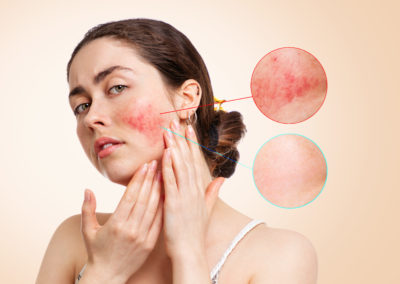Rosacea
What is Rosacea?
- Rosacea is a chronic and inflammatory condition that most often starts between the ages of 30 and 60 years.
- It typically has an active, relapsing and remitting course.
- Some patients may have relief for years at a time only to find rosacea reoccurs during times of stress, or with hormone changes such as pregnancy and menopause for women.
- Rosacea affects about 5% of the global population. People from all nationalities and races can get rosacea but it is doubly common in Caucasian people (especially with Celtic or English heritage).
- It affects both sexes equally.
- More than 77% of patients reported long-term remission of rosacea after medical treatment,compared to 42% of people who did not seek medical treatment for rosacea,according to a study in the Archives of Dermatology.*1
What are the symptoms of rosacea?
- Intermittent flushing often triggered by alcohol, sunlight, heat, hot foods/beverages.
- Persistent facial redness
- Sensitive skin. Stinging, irritation and increased redness with use of products on the face.
- Skin thickening, like orange peel with prominent pores.
- Red bumpy, or pimple-like lesions.
- Irritated, stinging, red or gritty eyes.
What are the different types of rosacea?
It can be annoying and uncomfortable and a common differential diagnosis (often incorrect is acne).
Phymatous rosacea is a severe and rarer type of the condition and causes prominent pores and thickening/swelling of the skin, generally around the nose. It is more common in older men.
What causes Rosacea?
Unfortunately this has science baffled and no “exact” cause has been found.
However the following are believed to be underlying causes:
- Genetic susceptibility (in particular and association with single nucleotide polymorphisms (a DNA sequence) related to the class II major histocompatibility complex (molecules responsible for initiating immune responses).
- Rosacea patients tend to have increased numbers of microscopic Demodex mites (dust mites) present on the facial skin. And dust mite reactivity is thought to play a role in the development of rosacea.
- Rosacea is an inflammatory condition that has been increasingly associated with a dysregulation of the immune response, which may lead to excessive inflammation and an increased risk of other inflammatory disorders affecting other parts of the body including depression, migraines, cardiovascular, gastrointestinal, and diseases. However many people with rosacea never develop these diseases, and if you have rosacea read here to find out how you can reduce your risk of developing other conditions.
- Rosace environmental triggers include alcohol, light, temperature change, exercise, spicy foods, alcohol, psychological stress, air pollution, and tobacco smoking. Of these, the most significant environmental trigger is UV light as rosacea affected skin is more sensitive to exposure and UV light/sun damage increases skin inflammation.
What are the treatments for rosacea?
- There is no cure per se for rosacea, but combination of various medications and lifestyle changes can achieve disease control and improve cosmetic appearance.
- Generally a combination of treatments gives the best results.
- Without treatment, the symptoms may get worse over time.
Treatment of rosacea will depend on the type and severity of the condition.
Lifestyle Modification
- A healthy well balanced diet, quitting smoking and reducing alcohol consumption can all help with rosacea control.
- Regular moisturiser and soap-free wash will help maintain good general skin health and reduce skin sensitivity.
- There are specific products available for sensitive and rosacea-prone skin, which contain minimal fragrance and other potentially irritating components.
- Sun protection is extremely important all times of the year and keeping sun exposure to 20 minutes to half an hour a day when the UV index is over 3 is especially important. Also avoid sun between 10am and 2pm.
Topical Treatments
- These are creams, lotions and ointments applied to the skin. Typically they may contain metronidazole, azelaic acid, benzoyl peroxide, or antibiotic cream , (brimonidine and ivermectin). Eye Drops may be provided for people with ocular rosacea.
Oral Treatments
- Low dose antibiotics can be taken for four months safely for rosacea that is moderate to severe or not responding to topical treatments alone. If taking antibiotics it’s important to take a few months break every six months or so before going on antibiotics again.
Because low dose doxycycline for instance is low dose it is not thought to be such a big issue for antibiotic resistance and needs to be weighed up against not treating the illness. However your rosacea treatment should be carefully monitored by your dermatologist or GP.
Severe rosacea may require short course immunosuppressive medication.
Laser/Light-Based Therapy Treatments
- IPL (intense pulsed light) and lasers can treat rosacea facial redness.
- The safe use of lasers and light-based devices will depend on your natural skin colour and this is more suited for skin types with lighter skin and darker hair.
- Ablative lasers can be used to re-shape the nose in rhinophyma (which causes the large, bulbous bumps nose associated with rosacea.
Surgery
- For phymatous rosacea affecting the nose (rhinophyma) day surgery can be an option to re-shape the nose. We can refer to a plastic surgeon if required.
Sources:
77% of people in clinical studies reported that rosacea goes into remission, rosacea.org
Dermnet Rosacea
Rosacea: Incidence Treatments, types, causes, and symptoms * Medical News Today
Rosacea – Symptoms and causes – Mayo Clinic
Rosacea: Types, Causes, and Remedies – Healthline
All About Rosacea – Rosacea.org
Rosacea and Stress – News Medical
The differences between self-love and body acceptance- Australian Broadcasting Corporation


